Toronto City Hall
The Toronto City Hall, or New City Hall, is the seat of the municipal government of Toronto, Ontario, Canada, and one of the city's most distinctive landmarks. Designed by Finnish architect Viljo Revell (with Heikki Castrén, Bengt Lundsten, and Seppo Valjus) and landscape architect Richard Strong, and engineered by Hannskarl Bandel, the building opened in 1965. It was built to replace Old City Hall, which had housed city offices since 1899.[3] The current city hall, located at Nathan Phillips Square, is the city's fourth and was built to replace its predecessor which the city outgrew shortly after its completion.
| Toronto City Hall | |
|---|---|
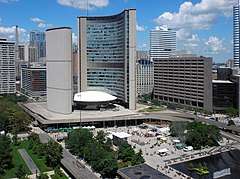 | |
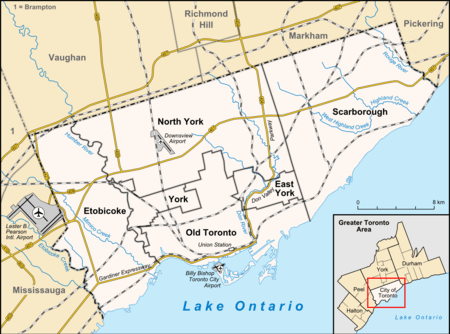 Location within Toronto | |
| General information | |
| Architectural style | Modernist |
| Location | Toronto, Ontario |
| Address | 100 Queen Street West |
| Coordinates | 43°39′12″N 079°23′02″W |
| Construction started | November 7, 1961[1] |
| Inaugurated | September 13, 1965[1] |
| Cost | $31 million[1] ($246 million in 2018 dollars[2]) |
| Owner | City of Toronto government |
| Height | 73.76 m (242.0 ft) |
| Technical details | |
| Floor count | 20/27 |
| Design and construction | |
| Architect | Viljo Revell |
| Structural engineer | Hannskarl Bandel |
| Awards and prizes | Ontario Association of Architects 25 Year Award (1998) |
| Renovating team | |
| Architect | Bruce Kuwabara |
| Designated | 1991 |
History
City leaders had been looking to build a more modern city hall to house its growing municipal government since at least 1943, when a report to city council recommended a new city hall and square in the block bounded by Queen Street West, Bay Street, and Chestnut Street. The recommendation was rejected by the electorate in a referendum on New Year's Day in 1947. However, in October 1952, a panel of citizens appointed by city council made the same recommendation. In 1954, leaders selected a partnership of three of Toronto's largest architectural firms: Marani and Morris, Mathers and Haldenby, and Shore and Moffat, to create a design. Presented in November 1955, their design proposed a conservative, symmetrical limestone-clad building in the Modernist style facing a landscaped square. Unlike the design that would ultimately be built, it retained the stone Beaux-Arts Registry Office on the western part of the site and also included a landscaped public space in front of it. The podium of the new city hall was to house the council chambers, and was given columns to complement the eight columns of the Registry Building, with which it was aligned across the new public space in front of it.
The scheme was panned by leading architects, including Frank Lloyd Wright (who called it a "sterilization" and "a cliché already dated") and Walter Gropius (who deemed it a "very poor pseudo-modern design unworthy of the city of Toronto"),[4] and all classes of the University of Toronto Faculty of Architecture co-authored a letter condemning the proposal and calling for an international competition. The whole $18 million proposal was scrapped when voters rejected it in a December 1955 referendum. The parti was adapted by the architects and built as the Imperial Oil Building on St. Clair Avenue West.
Design competition
Led by Mayor Nathan Phillips, the Toronto city council decided in 1956 to hold an international competition to choose the new design under terms created by the International Union of Architects. This caused some controversy as some felt the work should be done by a Canadian. Phillips assembled a five-person panel of judges from some of the world's greatest architecture experts with Eric Arthur serving as advisor.
By the deadline of April 18, 1958, the committee received over 500 designs from 42 countries from it which it selected eight semi-finalists. In September 1958, three judges selected Viljo Revell's design, though it almost missed the short list. Eero Saarinen, as member of the panel of five judges, arrived a day and half late and chose Revell's design from the other judges' list of entrants that could summarily be rejected. He convinced two other judges on the panel that Revell's unique design should be the winner.[5] One of the two dissenting judges was William Graham Holford, who was skeptical that the design could be built within the $18 million budget set by the city. Revell received a $25,000 prize plus an estimated $1 million in fees to supervise construction. He complained that not enough credit was given to his design collaborators, Heikki Castren, Bengt Lundsten, and Seppo Valjus, and asked that all names be listed as the architects. Revell died in 1964 before the project was finished.
Construction
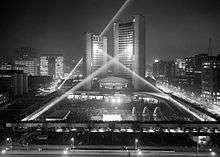
Construction began in 1961, and the building was completed four years later. The time capsule for City Hall was placed in a large ceremony on November 7, 1962 and Governor General Georges Vanier officially opened the new structure September 13, 1965.[6]
The area of Toronto City Hall and the civic square was formerly the location of Toronto's first Chinatown, which was expropriated and bulldozed during the mid-1950s in preparation for a new civic building.[7] The location of City Hall itself was also the site of the 1917 Land Registry Office. It was designed in the Roman Classical style and was itself intended as part of a prior urban renewal plan for the area. It was demolished in 1964.[8]
The south side of Queen Street opposite City Hall was considered a 'commercial slum' and in August 1964, Toronto City Council voted to expropriate the south side for development appropriate to the new civic square.[9] The businesses on that side of the street included two burlesque theatres, pawn shops and a cinema. The south side was vacant at the time of the City Hall opening but was eventually occupied by a new hotel, connected by a bridge over Queen Street to the square.
To the west of the new City Hall, the University Avenue Armouries at University Avenue just north of Osgoode Hall was bought from the Government of Canada for CA$2 million to make way for a new court building, also as part of the new civic square project.[10]
Design
.jpg)
While the building's base is rectangular, its two towers are curved in cross-section and rise to differing heights. The east tower is 27 storeys (99.5 metres (326 ft)) tall and the west tower is 20 storeys (79.4 metres (260 ft)). Between the towers is the saucer-like council chamber, and the overall arrangement is somewhat like two hands cradling the chamber. The outer surfaces of the curve are covered with concrete bearing a rib pattern that provides strength and prevents collapse of the fabric as a result of the expansion of the exterior surfaces, and the tearing apart of the fabric as a result of differences in air pressure on the two sides of each wing-like tower during the high winds characteristic of the Great Lakes. The north, west, and east elevations are more abstract and sculptural in contrast with the extensive glazing of south elevation facing the square; each presents a view of concave panels of concrete textured with split-faced strips of Botticino marble. To the east of the square is Old City Hall which currently serves as a courthouse. From the air, the building is seen as a giant unblinking eye, thus the building's original nickname of "The Eye of Government". When finished, the building generated widespread controversy among many who felt that it was "too futuristic" for the city.[11]
The design for the public space in front of the new city hall, Nathan Phillips Square, was part of the competition. The square's reflecting pool and concrete arches, fountain, and overhead walkways were thus also part of Revell's submission. It has since seen several monuments, sculptures, and other works of public art added, and was renovated, but it continues to complement the city hall with its original Modernist design elements.
Council Chambers
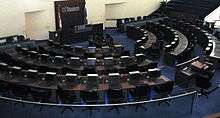
The City Council chambers is a semi-circular room located on the second floor supported on a single massive column below. On the main level of the chambers are the seats for the 25 members of Council, arranged in a semi-circle.
In front of the councillors is the podium and seat for the Speaker of Toronto City Council (or Deputy Speaker when Speaker is not present). Flanking the Speaker are two long tables for Commissioners (i.e., department heads); City Manager, Deputy City Manager, City Solicitor and Chief Financial Officer are seated to the right and City Staff on the left. In front of the Speaker is the horseshoe shaped desk for the City Clerk and Clerk staff. The mayor, is seated amongst councillors in the first row to the Speaker's right. A removable podium is located to the right of the Speaker for guest speakers. The room is covered by a shallow dome resting on 23 pairs of v-shaped supports that rise from the base. The space behind the supports is filled with glass.[12]
Behind the councillors is the public seating gallery which accommodates 250 in tiered rows. Adjacent to City Council chambers are two committee rooms, as well as the offices of the mayor and city councillors. Two sets of elevators provide access to the floors below (ground floor and to the parking garage below).

Additions and changes
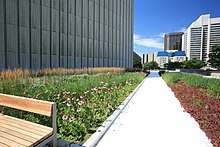

City Hall has changed over the last four decades:
- Hester How Daycare Centre opens 1990 and named after a Toronto teacher Hester How who helped turn around delinquent boys in the second half of the 19th Century.
- Minor upgrades by Toronto architect Bruce Kuwabara to connect the two towers and upgrade council chambers in 1997-1998
- East Tower Observation deck closed - the 27th floor deck has been opened during Doors Open and one councilor has asked for a seasonal opening[13] Access to the floor is via two sets of stairs as elevators end at 25th Floor.
- Gift shop closed
- City Hall library reduced in size
- The ice rink is still used for skating during winter, but people cannot use the pool/fountain area to wade in during summer
- A green roof was added late 2009 and opened to over 10,000 visitors on Doors Open Toronto weekend in May 2010. The site now contains largest publicly accessible green roof in the city.[14][15]
City Hall was designated as a property of historical and architectural significance under the Ontario Heritage Act in 1991. In 2005, the building celebrated its 40th birthday.
Events
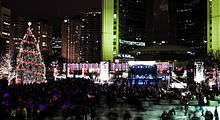
City Hall's forecourt, Nathan Phillips Square, is one of the main hosts of different festivals and events in Toronto. New Year's celebrations are held there every year which include fireworks and musical performances. The annual Cavalcade of Lights Festival decorates the square from the end of November until the end of December.
Various locations throughout the building are accessible to the public during Doors Open Toronto; council chambers, the Mayor's office, and 27th floor were included in 2009.
In popular culture

Even as early as 1969, the building appeared as a futuristic alien building in a Star Trek comic; it was later seen in the Star Trek: The Next Generation episode "Contagion" (Season 2, episode 11, March 20, 1989) as one of the possible destinations of an alien portal.[16]
In the 1980 film The Kidnapping of the President starring William Shatner and Hal Holbrook the city hall and Nathan Phillips Square provided the location for a protracted hostage scene.
In the 2002 film The Tuxedo, the city hall was playing the role of "CSA Headquarters". In the 2004 film Resident Evil: Apocalypse, the building portrayed the City Hall in Raccoon City. It was destroyed by a neutron bomb blowing up over the building. In the 2006 film The Sentinel, an assassination attempt takes place at a Group of Eight summit meeting in Toronto's city hall.
In the 2007 novel Consolation by Michael Redhill, Toronto's city hall is described as an ice cream cone with a tumour in between.
The Devon Corporation headquarters in the popular Pokémon anime franchise bears a striking resemblance to Toronto's city hall.
The 2010 film Red featured Toronto City Hall and various other city locations.[17]
The TV series Flashpoint also features Toronto City Hall in various episodes.
The flag of Toronto contains a stylized representation of the two towers of City Hall.
The software package lastools includes a 3d point cloud of the Toronto City Hall as demonstration dataset.
See also
References
- Osbaldeston, Mark (2008). "11: Toronto City Hall, 1925-1955 / Built to Different Plans". Unbuilt Toronto: A History of the City That Might Have Been. Toronto: Dundurn Press. Retrieved June 4, 2011.CS1 maint: ref=harv (link)
- Notes
- "Toronto City Hall tour - a brief history". City of Toronto. Archived from the original on June 7, 2011. Retrieved August 15, 2011.
- Canadian inflation numbers based on Statistics Canada tables 18-10-0005-01 (formerly CANSIM 326-0021) "Consumer Price Index, annual average, not seasonally adjusted". Statistics Canada. January 18, 2019. Retrieved March 6, 2019. and 18-10-0004-13 "Consumer Price Index by product group, monthly, percentage change, not seasonally adjusted, Canada, provinces, Whitehorse, Yellowknife and Iqaluit". Statistics Canada. Retrieved March 6, 2019.
- Ian Chodikoff "Days of Future Passed." The Canadian Architect. Vol. 50. Iss.8 (2005):26-27. Print. City of Toronto Archives. Toronto's New City Hall. n.p., n.d. Web. September 17, 2010.
- Osbaldeston 2008, p. 91.
- Osbaldeston 2008, p. 94.
- Filey, Mike (2004). Sketches 8: The Way We Were. Toronto: Dundurn Press. p. 135. ISBN 978-1459712584.
- Yee, Paul (October 19, 2005). Chinatown: An illustrated history of the Chinese Communities of Victoria, Vancouver, Calgary, Winnipeg, Toronto, Ottawa, Montreal and Halifax. Toronto: James Lorimer & Company Limited. ISBN 978-1550288421.
- "Toronto's old Registry Office Building". Historic Toronto. Retrieved August 13, 2019.
- "10 years to renew Queen - Manthorpe". Toronto Star. August 14, 1964. p. 31.
- "Armories Sale Definite". Toronto Star. August 6, 1960. p. 9.
- Nagy, Chris (September 13, 2015). "New City Hall Celebrates 50 Years as Centre of Toronto's Expression". Toronto Time Machine. Cite journal requires
|journal=(help) - "Toronto City Hall tour - Council Chamber". City of Toronto. Retrieved September 5, 2017.
- Shah, Maryam (February 1, 2016). "Kelly wants City Hall observation deck opened to public". Toronto Sun. Retrieved September 5, 2017.
- "Toronto City Hall Podium Sprouts a Green Rooftop Park". Inhabitat. Retrieved June 27, 2013.
- Rochon, Lisa. "An oasis at the top of City Hall". The Globe and Mail. Toronto. Retrieved June 27, 2013.
- Bunch, Adam (October 1, 2013). "Star Trek and Toronto City Hall". Spacing Toronto. Spacing. Retrieved January 27, 2019.
- Fleisher, David (January 27, 2011). "Reel Toronto: Red". Torontoist. Retrieved January 15, 2012.
External links
| Wikimedia Commons has media related to Toronto City Hall. |
- City of Toronto's history page
- Historical photos: Viljo Revell, the design competition, construction, and opening
- Emporis database listing
- Open Buildings:Toronto City Hall profile
- Contemporary photo gallery
- A grand design: Toronto City Hall and Square competition - submissions from architects for the 1958 design competition
| Preceded by none |
Seat for the Municipal Government of Metropolitan Toronto 1954–1992 |
Succeeded by Metro Hall |
| Preceded by Old City Hall (Toronto) |
Toronto City Hall 1965– |
Succeeded by current |